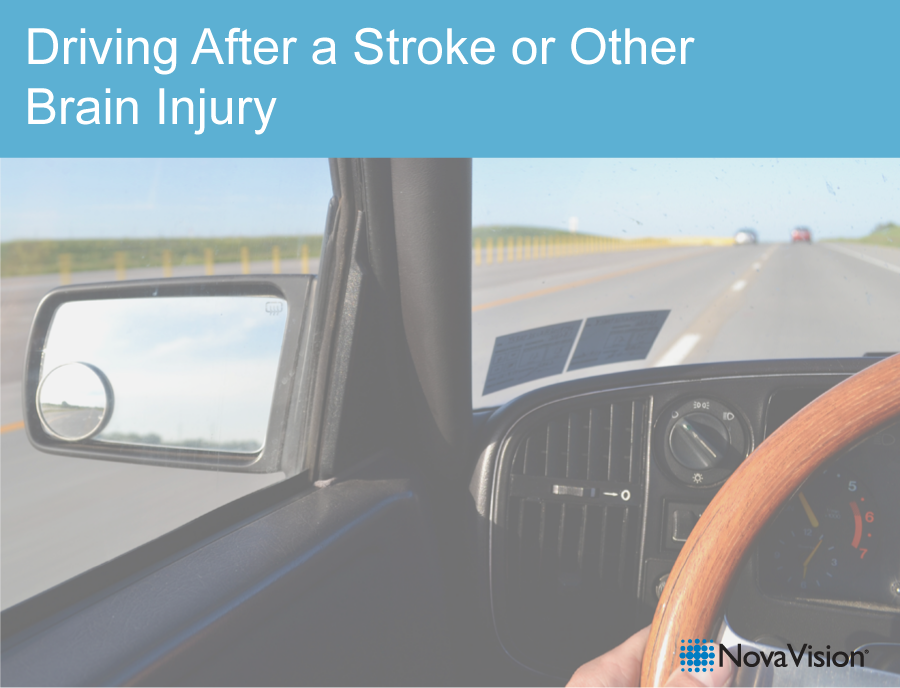
Are you allowed to drive a car when you have suffered a stroke, a traumatic brain injury other neurological disease? Can you drive a car with a visual field defect?
A person who suffered a stroke or traumatic brain injury might have to face many impediments when he/she wants to drive a car again. Balance problems, paralysis, slowed response times, concentration difficulties, decreased visual acuity or visual field loss are only some examples which can lead to a withdrawal of the driving permission, at least temporarily. Many people are dependent on driving because of their professional occupation or lack of public transportation in their place of residence and very soon need an answer to their question “Am I allowed to drive a car again?”
What are some warning signs of unsafe driving?
Often survivors may be unaware of the effects that a stroke or brain injury can have on their driving skills. If you or someone you know has experienced some of these warning signs of unsafe driving, please consider taking a driving test:
- Drives too fast or too slow for road conditions or posted speeds
- Needs help or instructions from passengers
- Doesn’t observe signs or signals
- Makes slow or poor distance decisions
- Gets easily frustrated or confused
- Often gets lost, even in familiar areas
- Has accidents or close calls
- Drifts across lane markings into other lanes
How can I tell if I can drive?
- Talk to your doctor or occupational therapist. They will offer a professional opinion about how your stroke might change your ability to drive. Contact your State Department of Motor Vehicles. Ask for the Office of Driver Safety. Ask what applies to people who’ve had a stroke or other brain injury.
- Have your driving tested. Professionals such as driver rehabilitation specialists can evaluate your driving ability. You’ll get a behind-the-wheel evaluation and be tested for vision perception, functional ability, reaction time, judgment and cognitive abilities (thinking and problem solving). Call community rehabilitation centers or your local Department of Motor Vehicles.
- Enroll in a driver’s training program. For a fee, you may receive a driving assessment, classroom instruction and suggestions for modifying your vehicle (if necessary). These programs are often available through rehab centers.
- Ask your family if they have seen changes in your communication, thinking, judgment or behavior that should be evaluated before you drive again. Family often have more opportunities to observe changes than others do.
What can you do if you are not allowed to drive?
- If the visual field defect is rather small (for example, a Quadrantonopia), there is a chance that with Vision Restoration Therapy from NovaVision the visual field may recover sufficiently to regain driving permission. Please contact NovaVision for further information. Every patient is different, and the results some patients may experience are not an indication of the results all patients may experience; however, NovaVision can provide you with real-live patient success stories.
- Various driving centers provide driving lessons for the disabled and also offer assistance in vehicle modification to suit people with various physical or medical conditions.
Each state may take its own approach to granting licenses to disabled drivers, but any driver who can pass the necessary exams with reasonable accommodation is eligible to receive a driver’s license. However, the driver is obligated to reveal their disability at the time of license application. The state DMV is entitled to grant a restricted license, depending on the nature of the disability. Restrictions are based on vision loss, hearing loss, and limb loss. The state DMV also grants handicapped parking permits. To obtain such a permit, the disabled individual must simply fill out an application and have it signed by a physician.
- Often it will not be possible to regain sufficient visual field to be allowed to drive again. As a responsible person, however, you have to face this new situation and change your life such that your quality of life remains even without driving. There may be a volunteer driver transportation program in your state; NVTCprovides a list of volunteer transportation providers in each state.
NOTE
Every driver has a responsibility not only for themselves but also for other traffic participants. A person who suffered a stroke or other brain injury should follow medical assessment procedures before driving again.
Sources:
http://www.carsdirect.com/car-buying/disabled-driving-how-to-get-your-drivers-license
http://web1.ctaa.org/webmodules/webarticles/anmviewer.asp?a=3767&z=132


